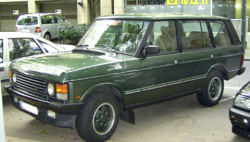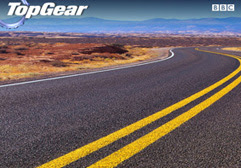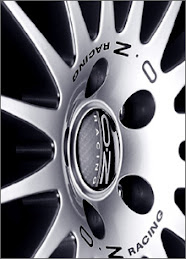 The Range Rover Classic is a luxury SUV that was built by British automaker Land Rover from 1970 to 1996. It was the first generation of vehicles produced under the Range Rover name. For most of its history, it was known simply as the "Range Rover"; Land Rover coined the term "Range Rover Classic" for the brief period they built them side-by-side with the P38A successors, and applied it retroactively to all first-generation Range Rovers.
The Range Rover Classic is a luxury SUV that was built by British automaker Land Rover from 1970 to 1996. It was the first generation of vehicles produced under the Range Rover name. For most of its history, it was known simply as the "Range Rover"; Land Rover coined the term "Range Rover Classic" for the brief period they built them side-by-side with the P38A successors, and applied it retroactively to all first-generation Range Rovers.Body
Like other Land Rover vehicles, most of the Range Rover's bodywork skin is constructed from lightweight aluminium, save for the two-section rear tailgate, and the bonnet on all but the earliest models. Apart from minor cosmetic changes,[2][3][4] the body design changed very little in its first decade.
One of the first significant changes came in 1981, with the introduction of a four-door body.[5] Until then, Range Rovers only had two doors, making access to the rear seats rather awkward. These doors were also very large and heavy. The four-door version was received well by the public; its popularity being such that the two-door was discontinued in the United Kingdom in 1984,[6] although the two-door continued to be produced to the end, mainly for the French market.[7] The front end of the Range Rover was revamped in 1986. This brought a more pedestrian-friendly plastic grille with horizontal slats, and front skirts with two driving lights.
Chassis and suspension
The Range Rover broke from the Land Rovers of its time by using coil springs instead of the then-common leaf springs. Because of its hefty weight, it also had disc brakes on all four wheels. Originally, it had no power steering, though this was added a few years after its introduction.[5]
One problem with the Range Rover chassis was that it suffered considerably from body roll. Because of this, the suspension was lowered by 20 mm (0.8 in) in 1980 [8], and later gained anti-roll bars.[9] Air suspension was introduced in 1992 for high-end models.[5]
Most Range Rovers had a 100-inch wheelbase. However, 1992 saw the introduction of a more luxurious model, branded the LSE in the United Kingdom and County LWB in the United States competing with the Lamborghini LM002. These had a 108 inch (2743 mm) wheelbase and 4.2 L engines.[10]
The 100-inch Range Rover chassis became the basis for the Land Rover Discovery, introduced in 1989.
[edit] Engines
Originally, the Range Rover was fitted with a detuned (135 bhp) version of the legendary Buick-derived Rover V8 engine. The 3.5 litre engine was bored out to a displacement of 3.9 litres (3947 cc) for the 1990 model year,[8] and 4.2 litres (4197 cc) in 1992.
Petrol-fuelled Range Rovers were fitted with carburetors until 1986, when they were replaced by Lucas electronic fuel injection,[8] improving both performance and fuel economy. Some export markets retained carburetors, with the original Zenith/Stromberg manufactured units being replaced by Skinners Union (SU)-manufactured items.
From 1979 onwards, Land Rover collaborated with Perkins on Project Iceberg, an effort to develop a diesel version of the Range Rover's 3.5-litre V8 engine.[11] Both naturally-aspirated and turbocharged versions were built, but the all-alloy engine blocks failed under the much greater pressures involved in diesel operation. The project was, therefore, abandoned. The effort to strengthen the Rover V8 for diesel operation was not, however, completely wasted; the 4.2-litre petrol variant of the engine used crankshaft castings developed in the Iceberg project.[12]
Because of the Iceberg failure, it was not until 1986 that Range Rovers gained diesel engines from the factory. The more efficient 2.4 litre (2393 cc) VM diesel from Italy was made available as an option for the heavily-taxed European market,[5] and were bored out to 2.5 litres (2499 cc) in 1989.[9] These were replaced by Land Rover's own 200TDi turbocharged diesel engine in 1992.[5]
[edit] Transmission
The Range Rover used permanent four-wheel drive, rather than the switchable rear-wheel/four-wheel drive on Land Rover's Series vehicles, and had a lever for switching ratios on the transfer box (called "high/low box") for off-road use. Originally, the only gearbox available was a four-speed manual unit (with an optional Fairey overdrive after 1977). A three-speed Chrysler automatic gearbox became an option in 1982, which was upgraded to a 4-speed ZF box in 1985, coupled to a LT230 transfer box.[8] The other major transmission upgrade in the Range Rover's lifetime was the switch from the LT95 combined four-speed manual gearbox and transfer box to the LT77 five-speed gearbox and separate LT230 transfer box in 1983.
[edit] Off road, and on
In June 1970, the Range Rover was introduced to the public, to much critical acclaim. It appeared that Rover had succeeded in their goal of a car equally capable both on and off road -- arguably, better than any four-wheel drive vehicle of its era in both environments. Road performance (a top speed of 95 mph (153 km/h) and acceleration from a standstill to 60 mph (97 km/h) in less than 15 seconds) was said to be better than many family saloon cars of its era,[13] and off-road performance was staggering owing to its long suspension travel and high ground clearance.
Notable off-road feats were winning the 4-wheel drive class in the first Paris-Dakar Rally in 1979 and 1981,[14], and being two of the first vehicles (along with a Series IIA) to traverse both American continents north-to-south through the Darién Gap from 1971–1972.
Special Range Rovers
The "In Vogue", a more luxurious special edition of the Range Rover, was produced in 1983. This went into full-fledged production as the Vogue.
In 1990 a special 20th anniversary edition of the Range Rover was created -- the Range Rover CSK (CSK being the initials of Charles Spencer King). Only 200 CSKs were ever made, all of which were two-door vehicles, and are now highly sought after vehicles. For a while, Spen King owned number 200, but this has since been sold on.[16]
One of Pope John Paul II's popemobiles, used on his visit to Scotland in 1982, was a Range Rover and truck hybrid built by British Leyland. The vehicle weighed 24 tons, and was said to be both bullet- and bomb-proof. It sold at auction in 2006 for £37,500.


























No comments:
Post a Comment